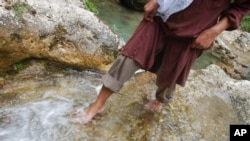The United Nations said in its yearly report on water access that the world is “facing a water crisis” and listed Iran as one of the countries experiencing “extremely high water stress.”
The U.N. World Water Development Report issued this week ahead of World Water Day, observed Friday, said that in the two decades ending in 2021, droughts affected more than 1.4 billion people worldwide, causing nearly 21,000 deaths.
In a report in August, the Washington-based World Resources Institute highlighted Iran among the 25 nations grappling with extremely high water stress.
The most water-stressed regions are the Middle East and North Africa, where 83% of the population is exposed to extremely high water stress, along with South Asia, where 74% is exposed, according to the report.
It said that the 25 countries — which house one-quarter of the global population — use over 80% of their renewable water supply for irrigation, livestock, industry and domestic needs, and that even a short-term drought puts these places in danger of running out of water.
The report named the five most water-stressed countries as Bahrain, Cyprus, Kuwait, Lebanon, Oman and Qatar.
Other countries in the top 25 were Saudi Arabia, Israel, Egypt, Libya, Yemen, Botswana, Jordan, Chile, San Marino, Belgium, Greece, Tunisia, Namibia, South Africa, Iraq, India and Syria.
Global water demand is projected to increase by 20% to 25% by 2050, while the number of regions facing water scarcity each year is expected to increase by 19%, according to the World Resources Institute.
For the Middle East and North Africa, this means 100% of the population will live with extremely high water stress by 2050, it said.
The institute's report cites Iran as an example where decades of poor water management and unsustainable water use for agriculture are already causing protests — tensions that will only intensify as water stress worsens.
Nikahang Kowsar, a water resources expert, told VOA, "Water scarcity in numerous countries worldwide, including the Middle East, stems from various factors, including population growth, unsustainable development, overutilization and the impacts of climate change, such as shifting precipitation patterns and increased evaporation."
Kowsar said top-down decision-making, the absence of democratic practices in governance and a lack of participation in decision-making are contributing factors exacerbating difficult conditions in numerous regions across Iran.
He further emphasized that "the overexploitation of aquifers to fulfill the demands of agriculture and urban areas has led Iran into water bankruptcy."
Kowsar said with the significant depletion of groundwater levels and the failure to replenish extracted water, it is anticipated that in the coming years, water scarcity in some regions of Iran will escalate, leading to instability and heightened tensions.
The World Resources Institute's says at least 50% of the world's population — around 4 billion people — live under highly water-stressed conditions for at least one month of the year, jeopardizing people's lives, jobs, food and energy security.








